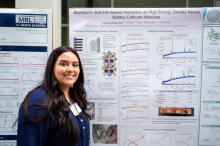
Major:
University:
Mentor(s):
Faculty Sponsor(s):
Faculty Sponsor's Department(s):
Project Title:
Project Description:
Batteries are essential to society for devices such as cell phones, computers, electric vehicles, etc., requiring high voltages and capacities which allow them to have high-energy densities. As we rapidly accelerate towards a more electric world meant to enable an environmentally friendly, sustainable future, the process of producing these batteries presents several environmental, geopolitical, and ethical concerns based on their large dependence on lithium, nickel, and cobalt in the cathode. However, sodium (Na) and iron (Fe) are well poised to replace these metals as they are more abundant, geographically dispersed, and less expensive. Recently, the weberite crystal structure (Na2M2+M’3+F7) has emerged as promising for future cathode materials based on its fast Na+ diffusing structure and breadth of compositional variants. Previous studies by the lab on variants of Na2Fe2F7 have shown that Mn2+ doping leads to metastability while Mg2+ better stabilizes the structure. Motivated by the improved structural stability with a diamagnetic dopant and an interest in better understanding the M3+ site, we have prepared a series of Al-doped compositions (Na2AlxFe2-xF7, x = 0.125, 0.25, 0.5, 1) via a mechanochemical-assisted solid-state synthesis method. The resultant product has been analyzed via lab X-ray diffraction and the data fit via the Rietveld method to determine the phase purity and crystal structure. These results show that we have for the first time successfully prepared Al-doped Fe weberites approaching 90% phase purity. In order to electrochemically test the materials, they were carbon coated in a ball mill to improve their electronic conductivity. Upon carbon coating the lowest Al-content composition for 24 hrs, it was found that the weberite structure decomposed. However, for higher Al concentrations, it was found that the weberite structure could be retained if a shorter carbon coating process was used. Their preliminary electrochemistry is presented and shows respectable reversible capacities of 50 mAh/g. Our preliminary results suggest that we have successfully incorporated Al into the weberite structure. Future structural analysis through 23Na, 19F, and 27Al solid-state NMR, 57Fe Mössbauer spectroscopy, and Synchrotron X-ray diffraction will enable a fundamental understanding of the M3+ site in the weberite structure, thus enabling the development of high-performance Na-ion weberite cathodes.
